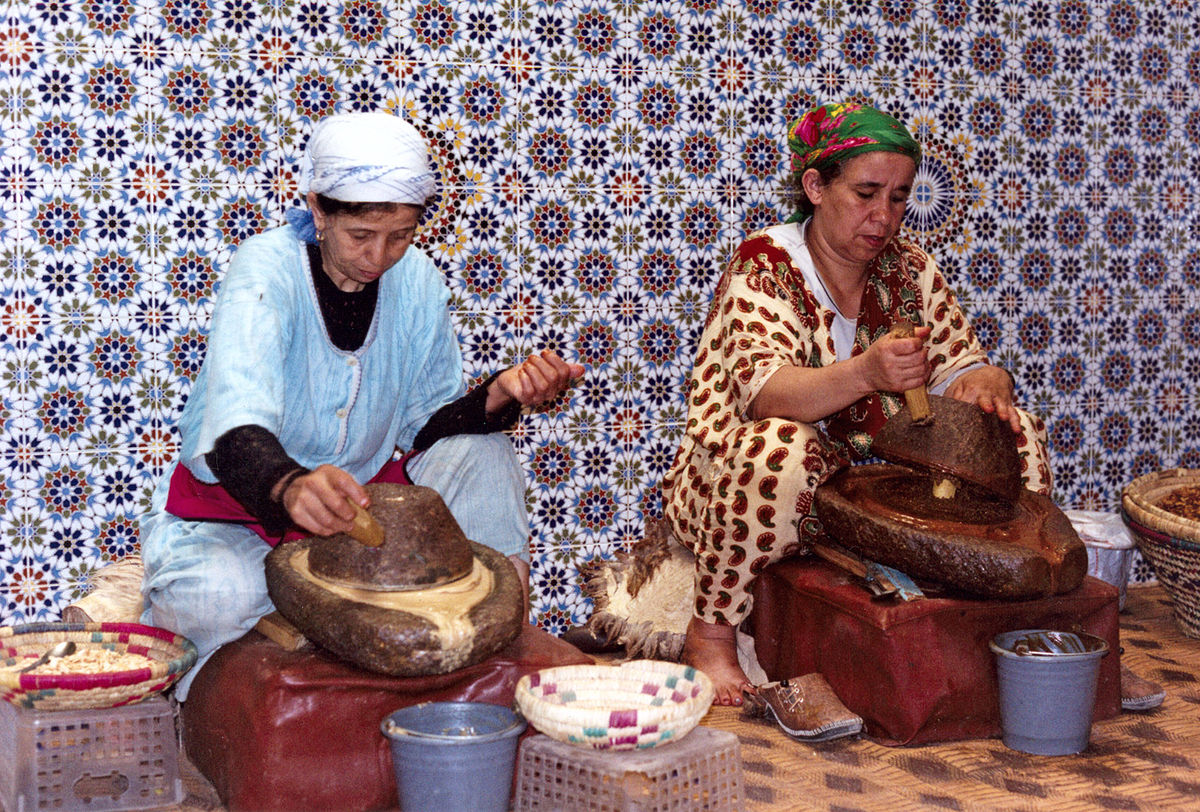Society
10.2.2023
Argan oil: when Moroccan culture is exported to cosmetics giants

Derived from the Argania Spinosa tree, which grows in southern Morocco, argan oil has gone from being a culinary and therapeutic cultural staple to one of the most coveted ingredients in cosmetics.
Visiting the arid region surrounding Essaouira and Agadir in Morocco, one would notice one type of tree thriving more than the others: the Argania Spinosa. This tree, adapted to withstand scorching temperatures that can soar above +50 ºC, bears fruit each spring, which is then cold-pressed to extract argan oil, one of the major breathing lungs of Essaouira’s economy.
Goats in an Argan Tree near Essaouira, Morocco pic.twitter.com/ez1jAniyEn
— Ed Lamon (@ed_lamon) June 29, 2023
Roots from the Moroccan soil
The argan tree is said to have originated in the town of Argana, northeast of Agadir. This tree outlives the olive tree and requires no deliberate cultivation. Its gnarled trunk provides an unusual spectacle, allowing goats to scale its branches and graze on leaves and fruit. The argan fruit boasts a green, fleshy exterior, resembling an oversized olive. Located within is a tough-shelled nut, housing one to three almond-shaped kernels.
The production of argan oil begins with the seeds of the argan tree. Once prolific throughout North Africa, it now exclusively grows on a slender stretch of arid land between Morocco’s Atlantic coast and the Atlas Mountains.
For centuries, the indigenous people of Morocco have valued argan oil for its healing properties, using it to reduce the appearance of scars and address rheumatic problems. Today, argan oil has transitioned from a traditional remedy to a highly sought-after commodity in the beauty industry. In the culinary world, its nutty flavor graces the menus of numerous restaurants. Crafting just one kilogram of this oil requires a staggering 30 kilograms of argan nuts.
Voir cette publication sur Instagram
“It contains all the positive vibes of these artisans, their laughter, the stories they share as they’re working. There’s a spiritual quality that makes it special and unique,” explained Amel Hentati, founder of all-women argan oil workers’ cooperative Marjana, to the AFP.
Such is the rarity of this tree that it has earned a spot on the UNESCO World Heritage list. It also finds application in the construction industry, owing to its exceptionally robust wood. Modern times have brought stricter regulations for argan tree felling, but their numbers continue to dwindle, leaving this species threatened with extinction.
Voir cette publication sur Instagram
Producing just one liter of argan oil involves approximately 24 hours of labor-intensive work. This, combined with the tree’s scarcity, lends argan oil its precious status—a product with a history spanning centuries in Morocco.
“All I’ve known all my life is argan oil,” said Samira Chari, a worker in Marjana, to the AFP.
“For me, it’s as essential as oxygen and water.”
From the Atlas to the global cosmetics market
With surging global demand, the Argan Oil market is poised to reach a staggering worth of $427.05 million by 2030. This versatile oil finds itself graded for both food and cosmetic use, where it goes by its INCI name, Argania spinosa kernel oil. Over the past 15 years, cosmetic argan oil has risen to prominence as a key player in the dermocosmetic industry. The beauty argan oil is crafted through the cold-pressing of argan-fruit kernels, while as a cosmetic ingredient, it undergoes solvent-assisted extraction from crushed kernels. Enriched-argan oil, derived from the distillation of cosmetic argan oil and supplemented with antioxidants, contains even greater cosmetic potential.
Notably, the argan tree’s fruit pulp and leaves contain proteins, peptides, saponins, and other compounds of great interest in the world of dermocosmetics. For this reason, the argan tree, scientifically known as A. spinosa, has earned the moniker of “A. cosmetosa.”
popular

